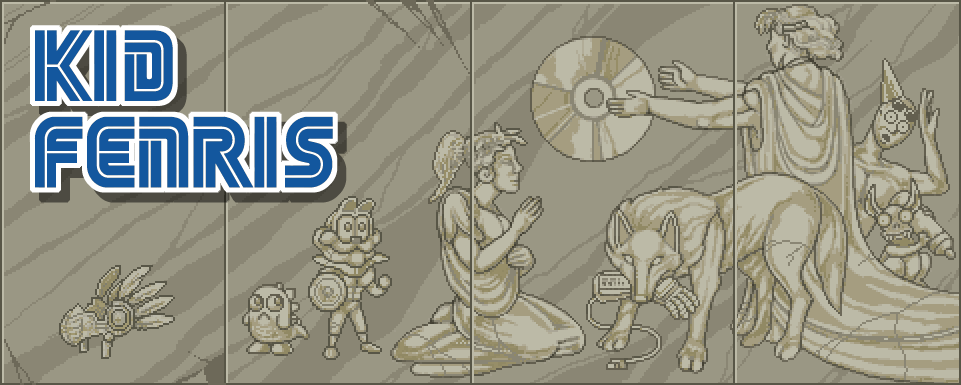
Those who read Electronic Gaming Monthly in the mid-90s may remember the “What Ifs” column with which the mag sometimes killed space. This section invited readers to send in witticisms on par with “What if the Little Mermaid was Ecco's Mother?” or “What if Atari decided there weren't enough buttons on the Jaguar's controller?” It was not, in retrospect, the magazine's finest attraction, but the terse banality of “What Ifs” appealed to kids and those older readers who couldn't write full-length letters.
To this day I'm not sure what possessed me to jot down some “What Ifs” of my own in late 1994, though I could blame it on being bored during Christmas vacation and unconvinced that I had outgrown video games. Whatever the cause, I sent off a dozen bon mots to EGM and promptly forgot about them, as I had Final Fantasy VI (then III) to worry about.
About four months later, someone passed the March 1995 issue of EGM2 around fifth-period German class. Once it was in my hands, I flipped to the letters section, for I suddenly remembered those stupid “What Ifs" and was gripped by a hysterical urge to see if I, a humble lad from a small Ohio town, would find my name in print.
And I did.

Yes, that's me at the bottom of the list, delivering some comedic misfires about Final Fantasy III, Mortal Kombat II, and a lesser-known, lesser-quality arcade fighter called BloodStorm, which gave rise to the Tempest gag. You see, one of her finishing moves was called the “Exorcism.” It was funny then, dammit.
This wouldn't seem a grand event today, but back in 1995, I was thrilled. With these four “What Ifs” printed, I was now a published writer. Forget that worthless short story in the school's literary magazine. This was E-MOTHERFUCKING-G-M. Yes, I was a stupid kid, and I make no excuses for it. In fact, I still feel some small surge of accomplishment when I look at the column and note that, for example, I received more space than any other contributor. Take THAT, Iain Hend! Where's your precious "Internet" now?
Of course, the issue has points of interest aside from unfounded nostalgia. For one, it's an interesting look at all of the game systems that were desperately vying for attention in 1995. With the 3DO, the Jaguar, the CD-i, the SNES, the Genesis, the 32X, the Sega CD, the slowly building culture of PC games, and the recently announced PlayStation and Saturn, it was an absolute clusterfuck. Though the two newest systems get the nicest previews in this issue (remember when Cyber Sled impressed us?), the 16-bit consoles seem to have the better libraries, thanks to titles like Ristar, Metal Warriors, Ogre Battle, Front Mission, and Comix Zone. But hey, CD-i owners could look forward to Thunder in Paradise, a multi-genre piece based on Hulk Hogan's short-lived syndicated TV series. The CD-i is seldom praised.
The year was also dominated by fighting games, and the issue dedicates an accordingly generous share of pages to Virtua Fighter 2, Killer Instinct, Capcom's X-Men fighter, and, of course, Mortal Kombat 3. The magazine's standout article is an interview with Anthony Marquez, a martial artist who provided motion-capture work for Kung Lao in both Mortal Kombat 2 and 3. It's a standard puff piece, though even Marquez weighs in on the issue of gaming violence when he submits that “parents have to take responsibility and not blame bad parenting on movies or video games.”
Yet the most intriguing thing in this issue might be a preview for a home version of BloodStorm, the mediocre, gore-filled fighter that inspired a “What If” from me. Though the game had a short run in arcades during 1994, ports for the PlayStation and Saturn were apparently announced the following year. EGM2's preview is sloppily vague, and the grainy screenshots suggest either an ugly translation or poor image quality, but it's the only evidence I've seen that BloodStorm was headed for a console. It was canceled, of course, after a Genesis version of Time Killers, BloodStorm's direct ancestor, turned out to be even worse than its arcade original.
That's about it for the April 1995 issue of EGM2. The layouts are only passable and the writing sticks to the same bland, grade-school tone that the EGM offices employed during the mid-1990s, but it has value as a study of an incredibly competitive gaming culture that may never be duplicated. And perhaps it shouldn't be.
